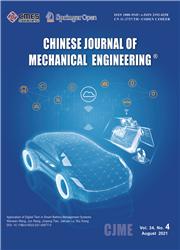有序微槽电镀砂轮磨削力的预测
IF 4.5
2区 工程技术
Q1 Engineering
引用次数: 1
摘要
摘要预测磨削力对磨削过程的控制、监测和优化具有重要意义。很少有理论模型来预测在磨削过程中使用结构砂轮时的磨削力。本文旨在建立单粒切削力模型来预测磨削过程中的犁耕力、摩擦力和切削力。考虑到砂轮的实际形貌,建立了有序微槽砂轮磨削淬硬AISI 52100的磨削力理论模型。该模型的创新之处在于将未变形切屑的随机厚度用概率表达式表示出来,清晰地反映了结构轮的微观结构特征。请注意,微观结构取决于砂轮上的突出高度和沙砾分布密度的随机性。通过平面磨削实验对所提出的力预测模型进行了验证,结果表明:(1)预测力与实测力吻合较好;(2)预测力随磨削参数变化的变化与实验结果吻合较好。提出了一种具有有序微槽的电镀砂轮磨削力理论模型,该模型准确、可靠、有效地预测了磨削力。本文章由计算机程序翻译,如有差异,请以英文原文为准。
Prediction of Grinding Force by an Electroplated Grinding Wheel with Orderly-Micro-Grooves
Abstract The ability to predict a grinding force is important to control, monitor, and optimize the grinding process. Few theoretical models were developed to predict grinding forces when a structured wheel was used in a grinding process. This paper aimed to establish a single-grit cutting force model to predict the ploughing, friction and cutting forces in a grinding process. It took into the consideration of actual topography of the grinding wheel, and a theoretical grinding force model for grinding hardened AISI 52100 by the wheel with orderly-micro-grooves was proposed. The model was innovative in the sense that it represented the random thickness of undeformed chips by a probabilistic expression, and it reflected the microstructure characteristics of the structured wheel explicitly. Note that the microstructure depended on the randomness of the protruding heights and distribution density of the grits over the wheel. The proposed force prediction model was validated by surface grinding experiments, and the results showed (1) a good agreement of the predicted and measured forces and (2) a good agreement of the changes of the grinding forces along with the changes of grinding parameters in the prediction model and experiments. This research proposed a theoretical grinding force model of an electroplated grinding wheel with orderly-micro-grooves which is accurate, reliable and effective in predicting grinding forces.
求助全文
通过发布文献求助,成功后即可免费获取论文全文。
去求助
来源期刊

Chinese Journal of Mechanical Engineering
ENGINEERING, MECHANICAL-
CiteScore
5.60
自引率
4.80%
发文量
3097
审稿时长
8 months
期刊介绍:
Chinese Journal of Mechanical Engineering (CJME) was launched in 1988. It is a peer-reviewed journal under the govern of China Association for Science and Technology (CAST) and sponsored by Chinese Mechanical Engineering Society (CMES).
The publishing scopes of CJME follow with:
Mechanism and Robotics, including but not limited to
-- Innovative Mechanism Design
-- Mechanical Transmission
-- Robot Structure Design and Control
-- Applications for Robotics (e.g., Industrial Robot, Medical Robot, Service Robot…)
-- Tri-Co Robotics
Intelligent Manufacturing Technology, including but not limited to
-- Innovative Industrial Design
-- Intelligent Machining Process
-- Artificial Intelligence
-- Micro- and Nano-manufacturing
-- Material Increasing Manufacturing
-- Intelligent Monitoring Technology
-- Machine Fault Diagnostics and Prognostics
Advanced Transportation Equipment, including but not limited to
-- New Energy Vehicle Technology
-- Unmanned Vehicle
-- Advanced Rail Transportation
-- Intelligent Transport System
Ocean Engineering Equipment, including but not limited to
--Equipment for Deep-sea Exploration
-- Autonomous Underwater Vehicle
Smart Material, including but not limited to
--Special Metal Functional Materials
--Advanced Composite Materials
--Material Forming Technology.
 求助内容:
求助内容: 应助结果提醒方式:
应助结果提醒方式:


